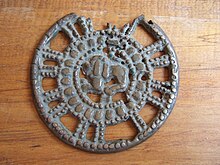Thokcha
A thokcha ( Tib . : thog lcags ; pronunciation: toktscha ) is an ancient metal object that is often worn as an amulet in Tibet . The Thokchas are sometimes ascribed "special powers"; in this respect they are comparable to the Tibetan Dzi (Tib .: gzi zhags ; necklaces) or malas made entirely or partially from Dzi (etched agate ).
Age
Thokchas can be roughly divided into two groups. The first includes objects that were found in pre-Buddhist times between around 1000 BC. And 900 AD, while the Thokchas of the second group are attributed to the time from around 700 to around 1800 AD due to their Buddhist motifs. Some of the early thokchas may have come from the still little explored Zhang Zhung culture of northwest Tibet.
Different types of thokchas
Thokchas are metal objects that can be between 2 and 15 cm long. Many of the early thokchas probably originally had practical uses and could have been parts of horse harness or as belt buckles or fibulas. Old arrowheads could also become thokchas. A large number of Thokchas represent mythological or real animals or deities from the Bon religion or Buddhism in Tibet . There are also abstract forms of thokchas, the meaning of which is still unclear.
Word meaning and popular belief
The term thokcha is made up of two words: thog means "above", "first" or "thunderbolt" and lcag is translated as "iron" or "metal". The meaning of the whole word can thus be given as “original metal”, “metal from above” or “sky metal” or “ meteorite iron”. Tibetan popular belief assumes that thokchas arise naturally or magically when lightning strikes the earth. Anyone who finds a thokcha on or under the earth will be particularly lucky and he or she will worship and wear this object for their entire life. There is also a popular belief that many thokchas were made from the metal of a meteorite. Most of the Thokchas, however, were created by artists from a copper alloy as an amulet. They are usually provided with an eyelet so that they can be worn around the neck with a leather strap. Some have multiple eyelets, which suggests that they were originally sewn onto clothing or utensils such as purses, lighters or bags.
bibliography
- Toni Anninos: Tokches - Images of Change in Early Buddhist Tibet . In: Orientations . October 1998, pp. 93ff.
- Toni Anninos: The Ancient Amulets of Tibet - Thokcha . The Max Maxwell Collection, San Francisco 2000.
- John Vincent Bellezza: thog lcags. In: The Tibet Journal. vol. 19 (1), Dharamsala 1994, pp. 92-97.
- John Vincent Bellezza: Thogchags: Talismans of Tibet . In: Arts of Asia. vol. 28, no. 3, May-June, 1998, pp. 44-64.
- Gudrun John: Tibetan amulets made of sky iron - The secret of the Toktschaks . VML-Verlag, Raden / Westf. 2006, ISBN 3-89646-034-X .
- Tung-Kuang Lin: Antique Tibetan Thogchags and Seals. The Art of Tibet . Taipei 2003.
- Hans Weihreter: thog-lcags. Mysterious amulets of Tibet . Edition Kyung, Augsburg 2002, ISBN 3-938221-00-3 .
Web links
- John Vincent Bellezza: Metal and Stone Vestiges. Religion, Magic and Protection in the Art of Ancient Tibet. on: asianart.com
Individual evidence
- ↑ Hans Weihreter: thog-lcags. Mysterious amulets of Tibet . Edition Kyung, Augsburg 2002.
- ↑ cf. dzi bead in engl. Wikipedia
- ↑ John Bellezza: Thogchags. on: asianart.com



